The Edith moon system
Table of contents
Jorlin
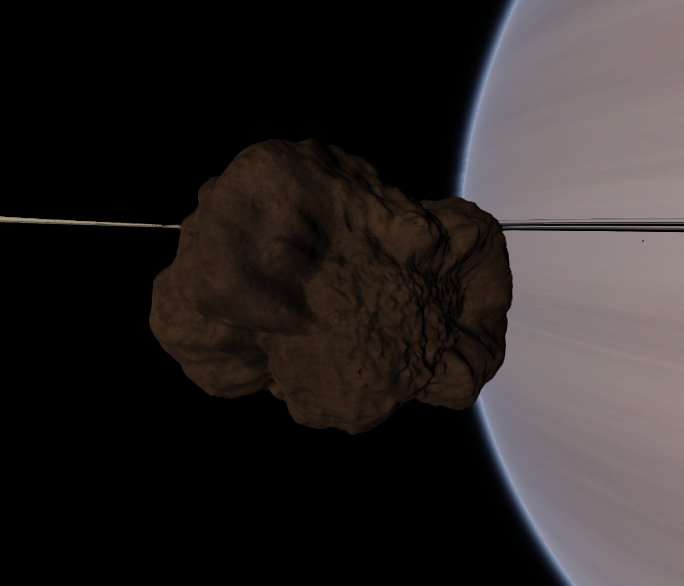
Jorlin as seen from space
Mass |
1.071E16 kg |
|---|---|
Radius |
5 km |
Gravity |
0.0025 g |
Rotation period |
Tidally locked |
Semi-Major Axis |
80,545 km |
|---|---|
Inclination |
0° |
Eccentricity |
0 |
Period |
8 h, 11 m, 56 s |
Jorlin is barely more than a particularely large rock that separated from Edith’s rings and migrated inwards, turning itself into a sheppard moon, stopping smaller objects from leaving Edith’s rings.
`
Jorlin spins really fast, actually, to where it is almost impossible to land on it in KSP. If you try to go for the equator, your craft will just be flung of. Its also orbiting past Edith’s roche limit, but its not being held together by gravity anyways. Its just a really large rock that’s sticking together chemically, like most rocks do.
`
Mefil
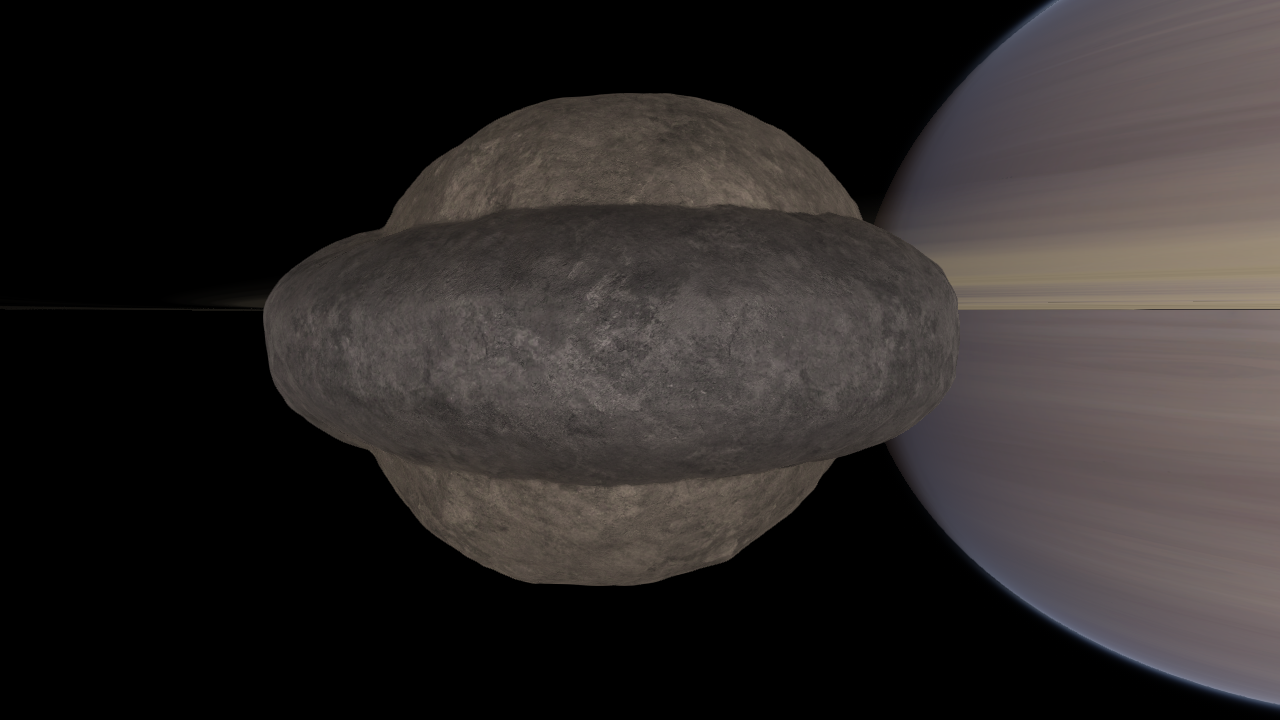
Mefil as seen from space
Mass |
7.879E16 kg |
|---|---|
Radius |
12 km |
Gravity |
0.0035 g |
Rotation period |
Tidally locked |
Semi-Major Axis |
125,545 km |
|---|---|
Inclination |
0.2° |
Longitude of Ascending Node |
12.8° |
Eccentricity |
0 |
Period |
15 h, 57 m, 18 s |
Mefil is a large object residing inside Edith’s ring system. A large amount of material has collected on its equator, giving it a strong bulge. It is also a sheppard moon, keeping the material in the rings in place.
`
Nothing much to say here. Its a flying saucer moon! Which do actually exist irl. I know Saturn has one.
`
Crinta

Crinta as seen from space
Mass |
6.0588E19 |
|---|---|
Radius |
138 km |
Gravity |
0.0221 g |
Rotation period |
Tidally locked |
Semi-Major Axis |
190,217 km |
|---|---|
Inclination |
0° |
Eccentricity |
0.0037 |
Argument of Periapsis |
117.8° |
Period |
1 d, 5 h, 45 m, 20 s |
Crinta is an odd moon, sitting right at the edge of being in hydrostatic equilibrium, where its gravity is powerful enough to force it into a round shape. As a result, it is debatable weather it counts as a major or minor moon, due to sitting right at the border between the two classifications. Its surface is partially flattened, but material deposited onto its surface from the rings has caused several large peaks to form.
`
Crinta’s a fun one. Instead of debating wether Pluto is a planet or not, the Avali get to fight over wether or not Crinta should be considered a major moon.
`
Ghorun
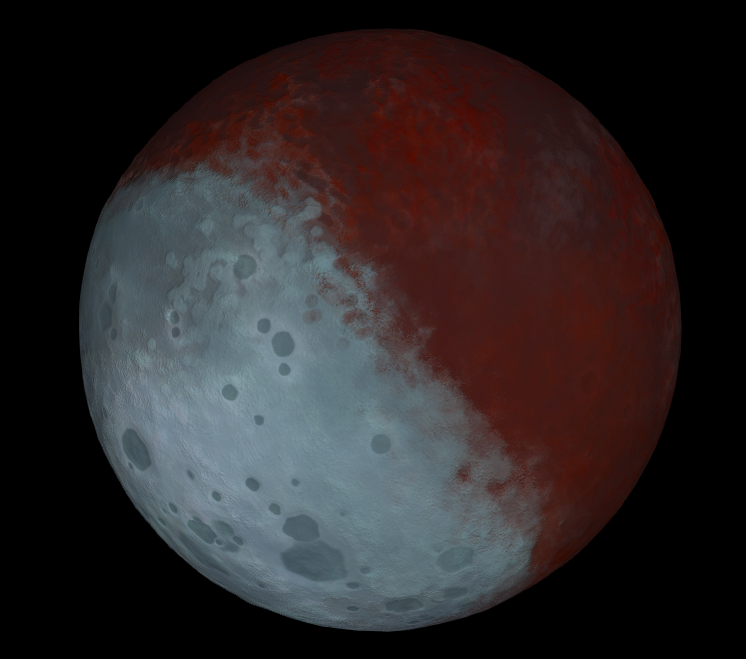
Ghorun as seen from space
Mass |
6.21E23 kg (8.4 times Moon’s) |
|---|---|
Radius |
2,567.68 km (1.4 times Moon’s) |
Gravity |
0.64 g |
Rotation period |
Tidally locked |
Semi-Major Axis |
285,117 km |
|---|---|
Inclination |
0° |
Eccentricity |
0.0081 |
Argument of Periapsis |
200.9° |
Period |
2 d, 6 h, 33 m, 25 s |
Ghorun is the first of three major moons in the Edith system (if Crinta is not counted as such), and the most massive. Its surface can be separated into two distinctly colored halves, as one half has a large amount of tholins deposited on it, giving it a distinct red coloration. Strangely, Ghorun is tilted on its axis, indicating a major event in the past. It is hypothesized that the Edith moon system underwent a whole series of collisions in the past, forming its rings from the scattered material, and possibly only leaving Ghorun as the sole survivor of the event, though with its axis tilted, and one half flattened by an impact.
It is also incredibly dense, being barely larger than some of the other moons in this solar system, but having an incredible gravitational pull for its size. It most likely contains a massive iron core, with only a thin layer of rock above it.
`
Ghorun was actually not just created by me, rather being a collab between me and a fellow KSP planet modder, Techo. I also like the implication here that Edith used to have a lot of smaller moons like Saturn does, but they all ended up in a sort of moon demolition derby after a large gravitational influence disturbed the entire system. What this influence was is not meant to be explained, but I like the Idea that it was Ghorun itself as it went to make a home for itself in the system. Alternatively, it was a rogue planet, which would be all too common this close to the galactic core.
`
Trultina
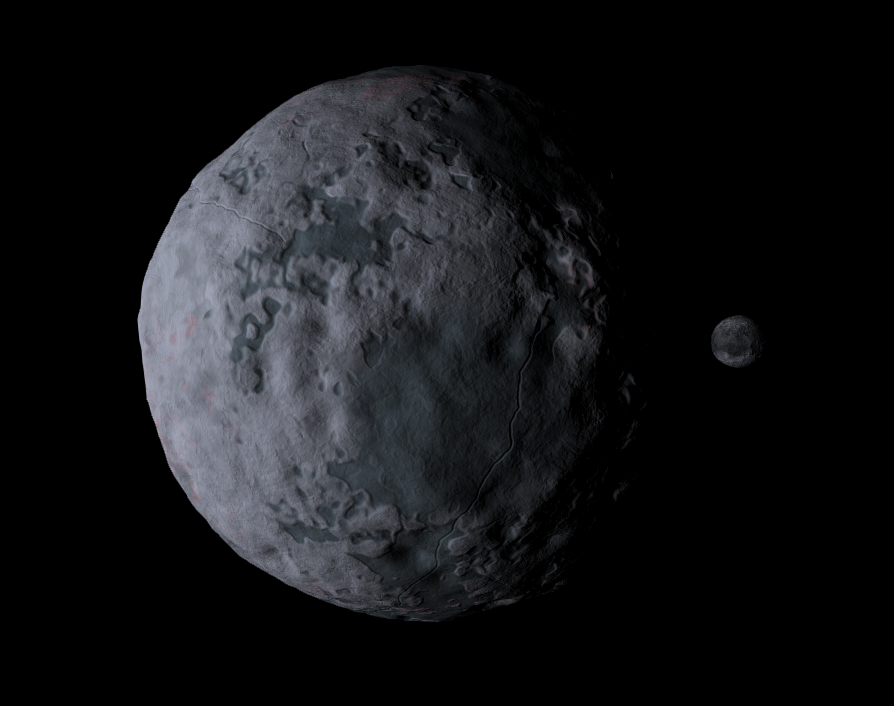
Trultina as seen from space
Mass |
4.696E21 (0.063 times Moon’s) |
|---|---|
Radius |
883.76 km (0.5 times Moon’s) |
Gravity |
0.04 g |
Rotation period |
Tidally locked |
Semi-Major Axis |
9,270 km |
|---|---|
Inclination |
0° |
Eccentricity |
0.042 |
Argument of Periapsis |
100° |
Period |
2 d, 9 h, 33 m, 10 s |
Semi-Major Axis |
811,055 km |
|---|---|
Inclination |
-2.3° |
Longitude of Ascending Node |
-33° |
Eccentricity |
0.037 |
Argument of Periapsis |
320° |
Period |
10 d, 21 h, 58 m, 46 s |
Trultina is an icy moon that is in a binary pair together with Trultosa, where both moons are constantly facing each other, as they orbit around their gravitational center. Trultina’s surface is mostly smooth, with barely any craters, and only slight tholin deposits. It has a similar warped appearance to Ralu, owing to the tidal forces excerted on it by its companion. It is also not very dense. Its size suggests a medium mass, but instead, it barely has a gravitational pull at all. Why this is is still poorly understood. Its surface also isn’t as cratered as its softness may suggest, indicating it migrated into this system recently, before being captured by Trultosa.
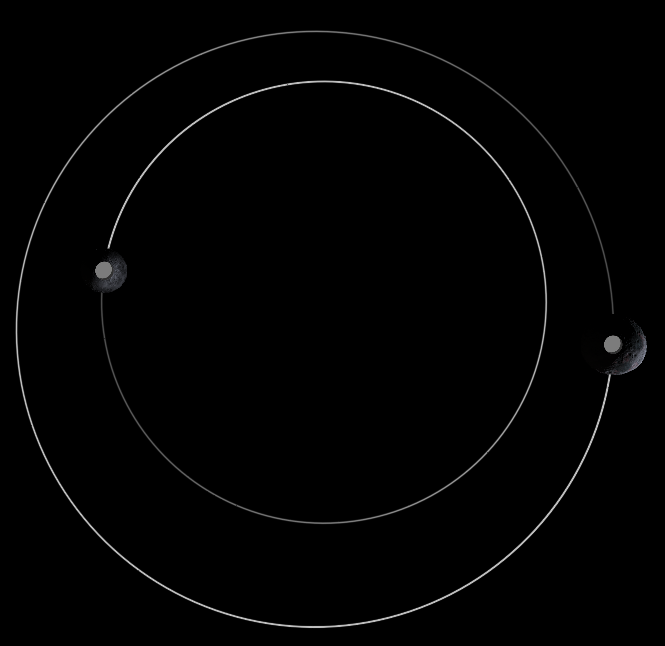
Visualization of the Trultina/Trultosa binary pair
`
Trultina and Trultosa form a close binary system. Binary moons like this are actually quite rare in nature, but I decided to put one here because it looks cool. I also decided to confuse people by making the smaller moon be the more massive, with the larger one just having a really low density. It looks quite paradoxical, having a much larger moon be pushed around by a relatively small one.
`
Trultosa

Trultosa as seen from space
Mass |
6.281E21 kg (0.085 times Moon’s) |
|---|---|
Radius |
683.79 km (0.39 times Moon’s) |
Gravity |
0.091 g |
Rotation period |
Tidally locked |
Semi-Major Axis |
6,931 km |
|---|---|
Inclination |
0° |
Eccentricity |
0.042 |
Argument of Periapsis |
100° |
Period |
2 d, 9 h, 33 m, 10 s |
Semi-Major Axis |
811,055 km |
|---|---|
Inclination |
-2.3° |
Longitude of Ascending Node |
-33° |
Eccentricity |
0.037 |
Argument of Periapsis |
320° |
Period |
10 d, 21 h, 58 m, 46 s |
Trultosa is the binary companion of Trultina, and has a incredibly cratered appearance, most likely a victim of the gravitational disturbance event that shocked this system in the past. It is many times more dense than Trultina, posessing a gravitational pull far greater than its size may suggest. It is instantly recognizable through its poles, which are strangely untouched by craters. Still, the fact that Trultosa features a very cratered appearance, while Trultina does not is further indication that the formation of their binary orbits is recent.
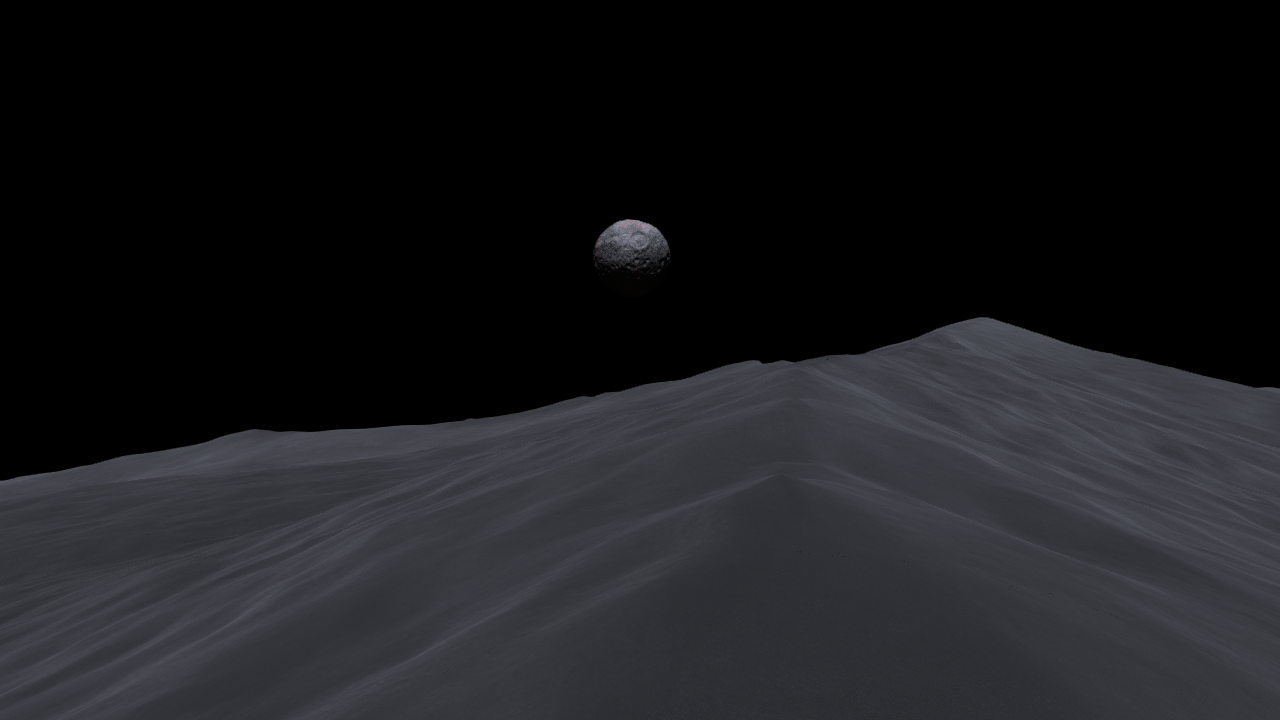
Surface view from Trultosa
`
For this one, I went "Hmm....what if I put craters onto a moon until it could hold no more?". Originally, all of Trultosa’s surface was just....craters. But relatively late into developing the mod, I decided to give it a more unique appearance by making its poles be devoid of craters, and of a lighter color.
`
Nalaki
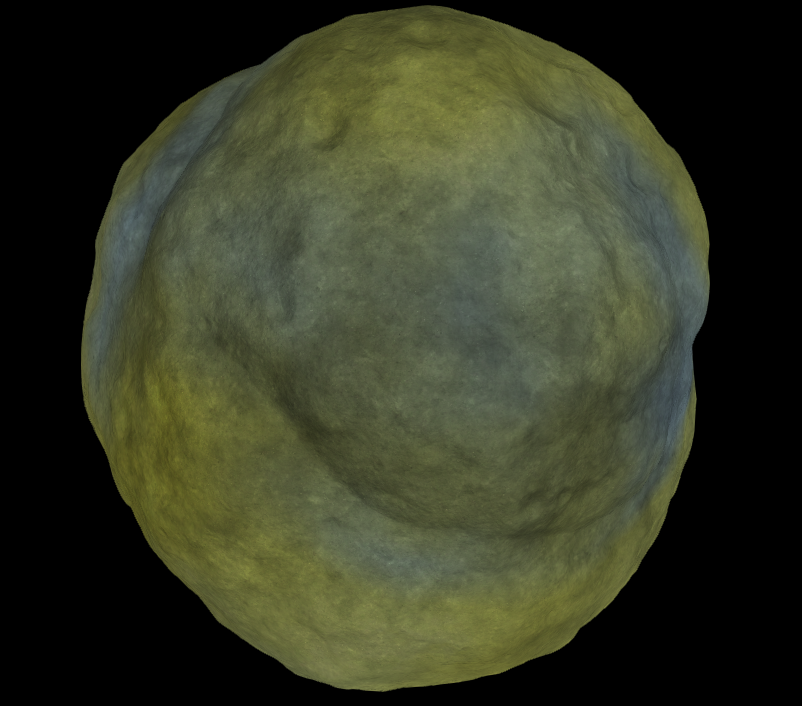
Nalaki as seen from space
Mass |
1.006E18 kg |
|---|---|
Radius |
21.4 km |
Gravity |
0.014 g |
Rotation period |
3 d, 1 h, 19 m, 1 s |
Semi-Major Axis |
1,450,000 km |
|---|---|
Inclination |
22.3° |
Longitude of Ascending Node |
98° |
Eccentricity |
0.16 |
Argument of Periapsis |
99° |
Period |
26 d, 2 h, 15 m, 7 s |
Nalaki is a minor moon of Edith that has a strangely yellow coloration, indicating the presence of sulphur on its surface. It is still quite large for a minor moon, and has a very uneven shape. Its high reflectiveness makes it outstandingly easy to observe with a telescope.
`
This one and Eanuk and Kaao are basically fillers, to be honest. I needed to pad out the Edith system for gameplay reasons in the mod, as well as pushing the Idea that Edith mostly only has minor moons orbiting it. Of course, Edith still has a massive amount of small rocks orbiting around it, just like Saturn and Jupiter do. I just decided that three of them would be noteworthy enough for the Avali to have cataloged them.
`
Eanuk
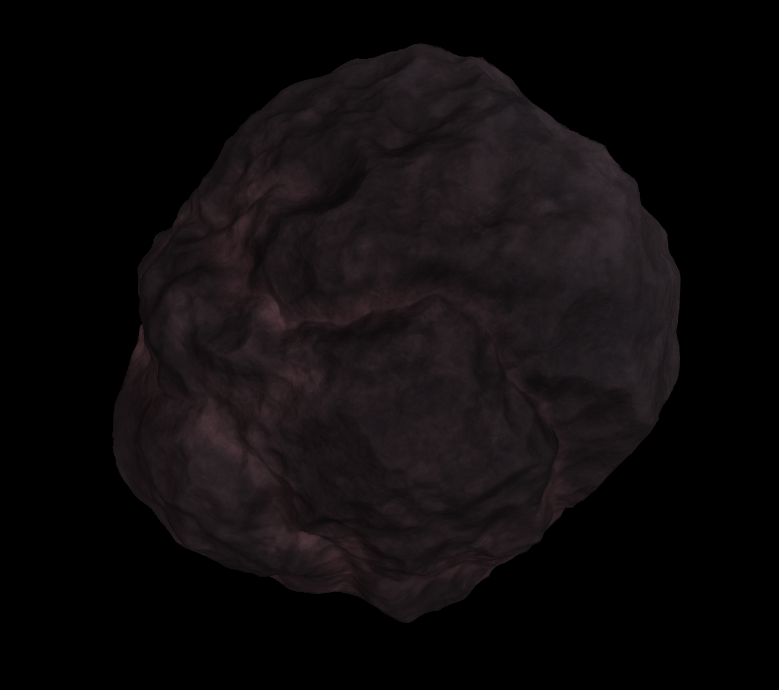
Eanuk as seen from space
Mass |
6.8E19 kg |
|---|---|
Radius |
17.4 km |
Gravity |
0.015 g |
Rotation period |
4 h, 22 m, 13 s |
Semi-Major Axis |
2,687,000 km |
|---|---|
Inclination |
37° |
Longitude of Ascending Node |
277° |
Eccentricity |
0.15 |
Argument of Periapsis |
68° |
Period |
65 d, 19 h, 47 m, 16 s |
Eanuk is a minor moon of Edith that was not discovered until recently, as it is incredibly dark to see, making it the last minor moon of Edith to be discovered on a stable orbit, and given a proper name. It is almost entirely covered in tholins, making it not just dark, but also red.
Kaao
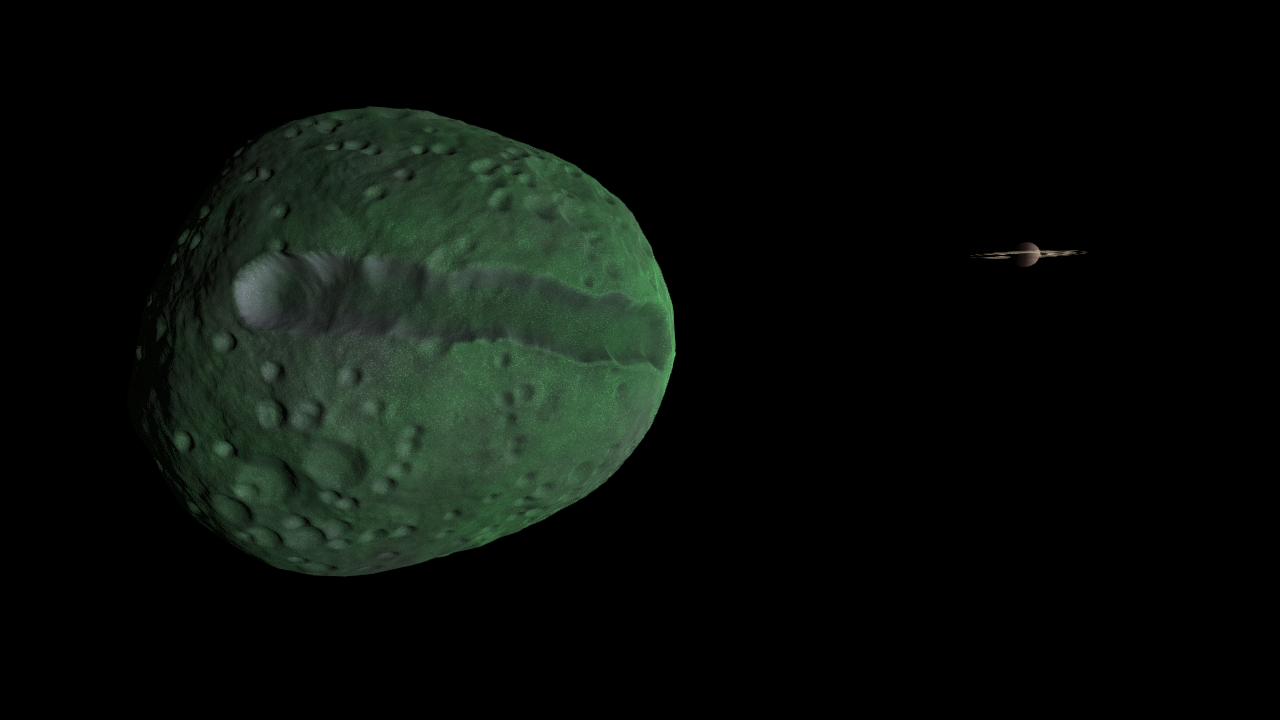
Kaao as seen from space
Mass |
7.6E19 kg |
|---|---|
Radius |
17.8 km |
Gravity |
0.0163 |
Rotation period |
2 d, 18 h, 17 m, 3 s |
Semi-Major Axis |
2,457,090 km |
|---|---|
Inclination |
-176° |
Longitude of Ascending Node |
10° |
Eccentricity |
0.28 |
Argument of Periapsis |
279° |
Period |
57 d, 13 h, 25 m, 47 s |
Kaao is a minor moon of Edith, notable for having a large gash of unknown origin in its surface. It is also the innermost object in this moon system that orbits retrograde.
`
Tried to spice this one up a bit. In-game, the massive ravine is really quite a fun place to land in. If you can get there. The retrograde orbit actually does make it quite challenging, if you are also planning to visit some of the other moons in the system.
`